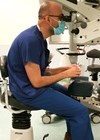Trainees archive for 2022
Myopia management
With the growing prevalence of myopia at epidemic levels in some countries and increasing number of research publications on myopia control, there is a lot of controversy regarding the management of myopia. As none of them are at present available...
The first on-call
You’ve made into ophthalmic specialist training and before you know it, it’s your first on-call shift. You are expected to provide the specialist on-call service out of hours and there is a new wave of responsibility, with, let’s be honest,...
Glasgow eye department continues to disrupt ocular simulation training through novel DRV system - the first of many?
Ongoing technological developments are enabling continuous progress to be made across all aspects of medical simulation training. This is particularly true within the field of ophthalmology, where surgical training advancements have enabled the role of simulation to expand dramatically over...
The 2021-2022 ophthalmology ST1 application process
Harry Rosen updates us on what is involved in the current UK Ophthalmology Specialist Training (OST) programme application process. The process of applying to the UK Ophthalmology Specialist Training (OST) programme is constantly changing each year, adapting to the needs...
COMMENT ON: Watch your back: Ergonomics and Ophthalmology
Jim Innes. Dear Editors, I write to congratulate Aadil Hussain on his excellent Trainees article “Watch your back: Ergonomics and Ophthalmology”. Please can I reassure him that, at least in the Yorkshire School of Ophthalmology, the importance of good posture...
Watch your back: Ergonomics and Ophthalmology
Aadil Hussain discusses an ophthalmologist’s risk of musculoskeletal injury and highlights the importance of ergonomics education, to ensure a pain-free career. Chronic and disabling musculoskeletal injury has been identified in the field of ophthalmology with increasing prevalence. The ophthalmologist is...
How good does my vision have to be to drive this thing? Visual standards for various occupations
We can all picture that moment in clinic: you are about to tell someone that they’re no longer legally able to drive, ready to deploy our ‘breaking bad news’ techniques. For some patients this may have been expected, or they...
A case of congenital lacrimal fistula: an overview of diagnosis and management
Shivam Goyal and Kyaw Htun Aye describe the challenges of dealing with a rare case of congenitial lacrimal fistula.We present a case of a 19-month-old baby with a congenital abnormality. Congenital lacrimal fistulae are a spot diagnosis due to its...
How to pass the FRCOphth part 2 oral exam
If you have got this far in terms of your exams, relax. In terms of pass rate, the hardest FRCOphth membership exams are already behind you. The pass mark for the part 2 oral exam is around 75%, and about...
Ocular bubbly: a vitreoretinal update on the art of gases
The authors remind us of the revolutionary impact gases have had on retinal surgery. In 1938, Rosengren attempted to improve his retina repair surgical outcomes [1]. He discovered that suturing the retina or pressing externally on the sclera were not...
Sclerochoroidal calcification masquerading as ocular malignancy
Case 1 A 68-year-old Caucasian gentleman was urgently referred to eye casualty by his optometrist after seeing an unusual incidental finding of protruding lesions from the retina, suspecting choroidal melanoma. He was asymptomatic and this was his first eye test...
Orbital cellulitis - an overview of the diagnosis and management
Periorbital (preseptal) and orbital cellulitis are infections of the subcutaneous tissues of the eye. They are differentiated by the location of the infection. Periorbital cellulitis refers to infection of the eyelid and subcutaneous tissues anterior to the orbital septum, whereas...
















